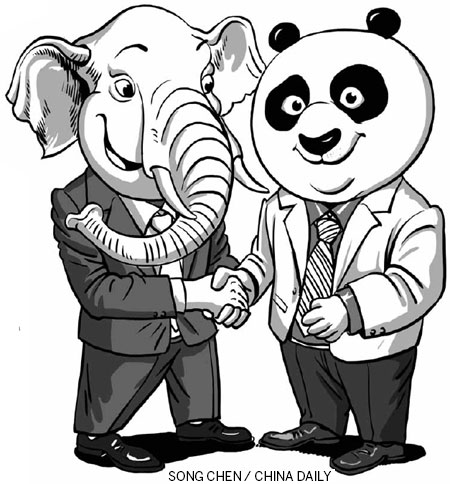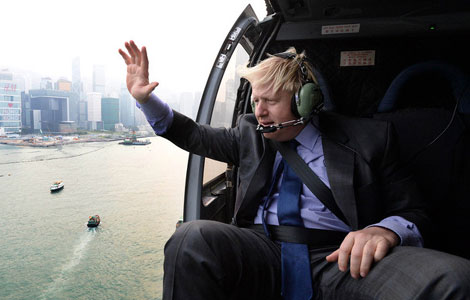A visit of vision and legacy
Updated: 2013-10-22 08:11
By Swaran Singh (China Daily)
|
|||||||||||
Indian Prime Minister Manmohan Singh's visit to China has elicited widespread media debates and commentaries much beyond the two countries. This is because these are the two largest and rapidly transforming countries and their mutual equation has global and systemic implications, which makes everyone a stakeholder in the success or failure of the visit.
Besides, this is Singh's first visit after China elected its new leadership and possibly his last before he demits office after having served for the third-longest term as India's prime minister. This makes the visit one of vision and legacy, too. In this context, Singh's recent visits to the United States and Russia can provide a precedent to his visit to China. If anything, Singh's recent visits to foreign countries reflect his increasing impatience with slow decision-making in New Delhi and desire to fast-forward his initiatives.
But deep down, Singh shares the Chinese belief in being low on expectations and high on pragmatism, which, in fact, has been typical of his decade-long stewardship. His visit to Beijing, therefore, will be remembered for few small ground-breaking yet bold initiatives through which New Delhi would redefine its equations with Beijing. This almost imperceptible shift in India's China policy flows from a growing understanding among the Indian elite that China-India relations have become increasingly asymmetric and therefore old strategies of dealing with China need to be reviewed.
The two sides are expected to sign several agreements, including the Border Defense Cooperation Agreement proposed by China on eve of Premier Li Keqiang's visit to India in May this year. They are also expected to sign a framework memorandum of understanding (MoU) on facilitating China's supplies of power equipment for Indian power projects and also one on clearing the decks for Chinese investments in India through Chinese industrial parks (like special economic zones) in five Indian provinces, Uttar Pradesh, Gujarat, Tamil Nadu, Andhra Pradesh and Karnataka. The two sides are also likely to sign an agreement to expand cultural exchanges.
After about a decade of vacillating, New Delhi recently decided to reform the visa regime. The expected result is another MoU, heralding a new visa regime to expand people-to-people contacts and facilitate business travel for trade and investment.
Under the new regime, the duration of business visa for Chinese visitors will be increased from six months to one year, employment and project visa applications will be cleared by India's Ministry of Home Affairs within the prescribed limit of 30 days and the bar on Chinese visitors returning to India before two months will be lifted. In addition, spouses and dependent family members of Chinese diplomats posted in India will be issued visas for equal duration.
However, just ahead of the visit, the Indian media raised doubts over whether an MoU on launching a new visa regime will be signed during the visit. In fact, the governments on both sides realize the importance of promoting people-to-people contacts to enhance mutual understanding. No matter whether the visa regime will be signed during the visit, such common view is and will still be shared by both governments.
More importantly, while the two sides may discuss these threadbare, the Indian side is likely to underplay its concerns over China granting stapled visas to Indian citizens as also their fears about the formidable and rising trade deficit. This has not only made bilateral trade somewhat one-sided, but also has slowed down trade growth, making it difficult to reach the $100 billion target by 2015.
According to the latest data, China-India trade - once described as the strongest pillar of their rapprochement - dropped from $73 billion in 2011 to $66 billion last year, and the trend for the first nine months of this year are hardly encouraging. In the face of declining Indian exports to China, the current trend indicates a further slowdown with their deficit having already hit $24.7 billion by September this year, and it's rising.
But perhaps the most important part of the visit will be Singh's speech at the Party School in Beijing on Oct 24. The invitation to speak at the apex ideology institute of the Communist Party of China's Central Committee is a rare honor and has never been extended to any Indian leader. This is where Singh will outline his vision for India's China policy and outline his legacy to be carried forward by future leaders from both sides.
The author is professor for Diplomacy & Disarmament at Jawaharlal Nehru University, New Delhi

(China Daily 10/22/2013 page9)
Today's Top News
UK official looks to China for support
Economy to see 'good ending' in Q4
Teacher killed in US school shooting
Border agreement to boost ties
US OKs Alibaba structure
Beijing works to spur global development
Scientists requested government to plant GM crops
Travelers to Europe bypass attractions of Brussels
Hot Topics
Lunar probe , China growth forecasts, Emission rules get tougher, China seen through 'colored lens', International board,
Editor's Picks

|

|

|

|

|

|





